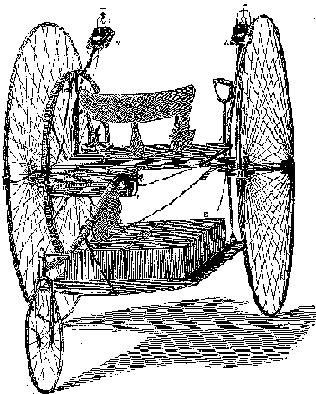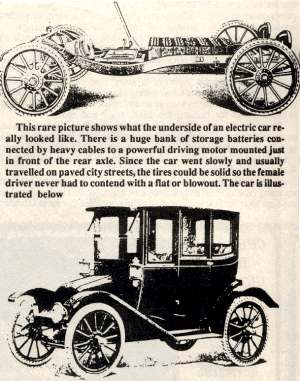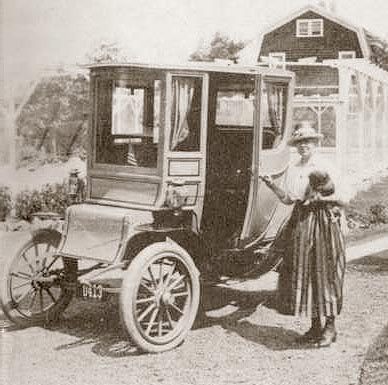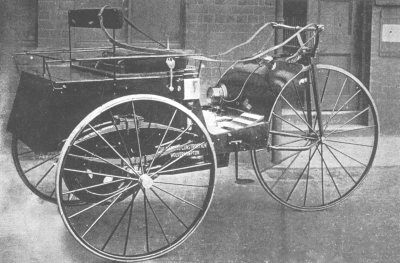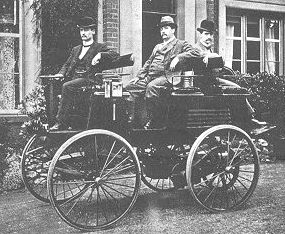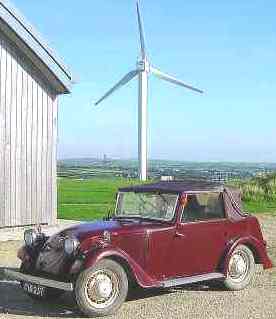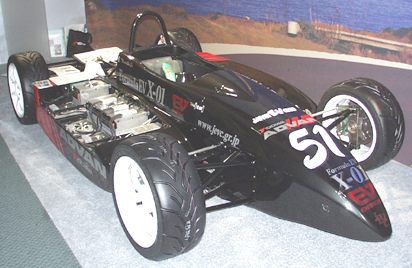|
HISTORY of ELECTRIC VEHICLES 1834 -
|
||
|
HOME | INDEX | AUTOMOTIVE | BLUEBIRD | ELECTRIC CARS | E. CYCLES | SOLAR CARS |
||
|
EARLY INNOVATION
Between 1832 and 1839, Robert Anderson of Scotland invented the first crude electric carriage. A small-scale electric car was designed by Professor Stratingh of Groningen, Holland, and built by his assistant Christopher Becker in 1835. Practical and more successful electric road vehicles were invented by both American Thomas Davenport and Scotsmen Robert Davidson around 1842. Both inventors were the first to use non-rechargeable electric cells. Frenchmen Gaston Plante invented a better storage battery in 1865 and his fellow countrymen Camille Faure improved the storage battery in 1881. This improved-capacity storage battery paved the way for electric vehicles to flourish.
Believed to be the first road going electric vehicle the Ayrton & Perry Trike of 1881
France and Great Britain were the first nations to support the widespread development of electric vehicles in the late 1800s. In 1899, a Belgian built electric racing car called "La Jamais Contente" set a world record for land speed - 68 mph - designed by Camille Jénatzy.
It was not until 1895 that Americans began to devote attention to electric vehicles after an electric tricycle was built by A. L. Ryker and William Morrison built a six-passenger wagon both in 1891. Many innovations followed and interest in motor vehicles increased greatly in the late 1890s and early 1900s. In 1897, the first commercial application was established as a fleet of New York City taxis built by the Electric Carriage and Wagon Company of Philadelphia.
Detroit electric carriage 1912
The early electric vehicles, such as the 1902 Wood's Phaeton (top image), were little more than electrified horseless carriages and surreys. The Phaeton had a range of 18 miles, a top speed of 14 mph and cost $2,000. Later in 1916, Woods invented a hybrid car that had both an internal combustion engine and an electric motor.
By the turn of the century, America was prosperous and cars, now available in steam, electric, or gasoline versions, were becoming more popular. The years 1899 and 1900 were the high point of electric cars in America, as they outsold all other types of cars. Electric vehicles had many advantages over their competitors in the early 1900s. They did not have the vibration, smell, and noise associated with gasoline cars. Changing gears on gasoline cars was the most difficult part of driving, while electric vehicles did not require gear changes. While steam-powered cars also had no gear shifting, they suffered from long start-up times of up to 45 minutes on cold mornings.
The steam cars had less range before needing water than an electric's range on a single charge. The only good roads of the period were in town, causing most travel to be local commuting, a perfect situation for electric vehicles, since their range was limited. The electric vehicle was the preferred choice of many because it did not require the manual effort to start, as with the hand crank on gasoline vehicles, and there was no wrestling with a gear shifter.
While basic electric cars cost under $1,000, most early electric vehicles were ornate, massive carriages designed for the upper class. They had fancy interiors, with expensive materials, and averaged $3,000 by 1910. Electric vehicles enjoyed success into the 1920s with production peaking in 1912.
Waverly Brougham - Colonel Mrs Smith
The decline of the electric vehicle was brought about by several major developments:
Thomas Hugh Parker, son of the founder the company, Electric Construction Company (ECC) was a brilliant innovator and inventor. He showed an early interest in powered vehicles and claimed to have had a battery powered car running as early as 1884.
He religiously obeyed the Light Locomotive Act, the red flag law, which lasted until 1896 and set a speed limit of 5m.p.h. on motorised vehicles. Thomas described Wolverhampton, as a hilly town without a single yard of level ground, between his house in Tettenhall and the town centre. During the remaining part of the century he built several other cars, one of which gave over 18 months trouble free service on daily runs to and from Tettenhall, to the works at Bushbury.
Thomas is credited with the design and manufacture of E.C.C.'s most famous car, the 'electric dog-cart', which was built in 1896. Reins were used to steer the vehicle because Mr. A. B. Blackburn, who was works manager, enjoyed horse riding and so the vehicle had to be as similar as possible to a horse-drawn one. The operation of the motor controller was by sliding seat.
EV DECLINE and REBIRTH
Electric vehicles had all but disappeared by 1935. The years following until the 1960s were dead years for electric vehicle development and for use as personal transportation.
The 1960s and 1970s saw a need for alternative fueled vehicles to reduce the problems of exhaust emissions from internal combustion engines and to reduce the dependency on imported foreign crude oil. Many attempts to produce practical electric vehicles occurred during the years from 1960 to the present.
In the early 1960s, the Boyertown Auto Body Works jointly formed the Battronic Truck Company with Smith Delivery Vehicles, Ltd., of England and the Exide Division of the Electric Battery Company. The first Battronic electric truck was delivered to the Potomac Edison Company in 1964. This truck was capable of speeds of 25 mph, a range of 62 miles and a payload of 2,500 pounds.
Battronic worked with General Electric from 1973 to 1983 to produce 175 utility vans for use in the utility industry and to demonstrate the capabilities of battery-powered vehicles. Battronic also developed and produced about 20 passenger buses in the mid 1970s.
Two companies were leaders in electric car production during this time. Sebring-Vanguard produced over 2,000 "CitiCars." These cars had a top speed of 44 mph, a normal cruise speed of 38 mph and a range of 50 to 60 miles.
The other company was Elcar Corporation, which produced the "Elcar". The Elcar had a top speed of 45 mph, a range of 60 miles and cost between $4,000 and $4,500.
In 1975, the United States Postal Service (see top image) purchased 350 electric delivery jeeps from the American Motor Company to be used in a test program. These jeeps had a top speed of 50 mph and a range of 40 miles at a speed of 40 mph. Heating and defrosting were accomplished with a gas heater and the recharge time was 10 hours.
ECC Dog Cart trike - photo Jim Boulton
Several legislative and regulatory actions in the United States and worldwide have renewed electric vehicle development efforts. Primary among these is the U.S. 1990 Clean Air Act Amendment, the U.S. 1992 Energy Policy Act, and regulations issued by the California Air Resources Board (CRAB). In addition to more stringent air emissions requirements and regulations requiring reductions in gasoline use, several states have issued Zero Emission Vehicle requirements.
The "Big Three" automobile manufacturers, and the U.S. Department of Energy, as well as a number of vehicle conversion companies are actively involved in electric vehicle development through the Partnership for a New Generation of Vehicles (PNGV). Electric conversions of familiar gasoline powered vehicles, as well as electric vehicles designed from the ground up, are now available that reach super highway speeds with ranges of 50 to 150 miles between recharging.
Some examples of these vehicles are the Chevrolet S-10 pickup truck (top image), converted by U.S. Electricar and no longer available. It was powered by dual alternating current motors and lead acid batteries. It had a range of about 60 miles and could be recharged in less than 7 hours.
The Geo Metro, converted by Solectria Corp., is an electric-powered 4-passenger sedan powered by an alternating current motor and lead-acid batteries. It has a range of 50 miles, and it can be recharged in less than 8 hours. During the 1994 American Tour de Sol from New York City to Philadelphia, a 1994 Solectria Geo Metro cruised over 200 miles on a single charge using Ovonic nickel metal hydride batteries.
The "Big Three" automobile manufacturers also developed electric vehicles. An early 1990s vehicle was the Ford Ecostar utility van with an alternating current motor and sodium sulfur batteries. The top speed was 70 mph and it had a range of 80 to 100 miles. While about 100 Ecostars were produced, it was considered an R&D vehicle and never offered commercially.
Ford offered an electric version of its Ford Ranger pickup. It had a range of about 65 miles with its lead acid batteries, had a top speed of 75 mph, it accelerated from 0 to 50 mph in 12 seconds, and it had a payload of 700 pounds.
ECC early electric carriage outside the family home The Manor House, Upper Green, Tettenhall Thomas Hugh-Parker middle seat
General Motors has designed and developed an electric car from the ground up instead of modifying an existing vehicle. This vehicle, called the EV1, was a 2-passenger sports car powered by a liquid-cooled alternating current motor and lead-acid batteries. The EV1 had a top speed of 80 mph, had a range of 80 miles, and could accelerate from 0 to 50 mph in less than 7 seconds.
In addition to the EV1, General Motors offered an electric vehicle Chevrolet S-10 pickup. This vehicle had a range of 45 miles, it accelerated from 5 to 50 mph in 10 seconds, and it had a payload of 950 pounds.
Other electric vehicles that were available during 1998 included the Toyota RAV4 sport utility, the Honda EV Plus sedan, and the Chrysler EPIC minivan. These three vehicles were all equipped with advanced nickel metal hydride battery packs. Nissan placed limited numbers of their Altra EV station wagons in California fleets during 1998. The Altra was equipped with a lithium-ion battery pack. In addition, both Ford and General Motors during 1998, made the Ranger, the EV1, and the S-10 pickup available with nickel metal hydride battery packs.
While the vehicles in 1998 satisfied the driving requirements of many fleet operators and two car families, the cost of $30,000 to $40,000 (1998) made them expensive. However, this cost was considerably lower when tax credits and incentives were included. Large-volume production and improvements in the production process are expected to reduce prices to the range of current gasoline-powered vehicles.
A 1936 electric Wilson - owner Dave Burford BVS
CHRONOLOGY
At
the cutting edge of electric vehicle development The Formula EV
X-01 comes all the way from Japan where it competes in the Japan
EV Club (JEVC). Sponsored by Yokohama tires, the EV racer weighs
1,322 lbs without batteries. The NiMh batteries weigh 582 lbs and
come from Panasonic EV Energy. They are wired to produce 237 volts
that runs through Café Electric Zilla Z1K-EHV motor controllers to twin
Advanced DC Motors XP-1227-A. Total power output for the EV X-01 is
209kW or 284 hp, which can propel the vehicle to speeds around 168 mph.
Formula EV X-01
Equally impressive is the technology in the 1000A Zilla liquid-cooled controllers (green cubes) designed and built in the USA by one of electric motorsport's most influential personalities. Electric drag racing today is almost entirely based on Otmar Ebenhoech's Zilla controllers. Some say you either run a Zilla, something custom, or you're just not competitive!
LINKS:
See also "http://www.driveclean.ca.gov/" for an official California site on ZEVs and PZEVs.
A page on this site, "http://www.driveclean.ca" will also list the available cars in various categories, especially informative if you are looking for an electrically powered city car (that page has no entries). EV NEWS STORIES
The EV Club of Japan
HybridCars.com - includes articles on hybrid electric cars and their impact on the environment. Howstuffworks: How Hybrid Cars Work - features an illustrated description of the parallel hybrid powertrain of the Toyota Prius. FutureTruck - information about the competition which challenges students to modify SUVs into fuel-efficient hybrid-electric vehicles. GreenHybrid.com - hybrid electric vehicle resource offering forums, articles, car comparisons, and performance statistics. Care2.com: Hybrid Cars - gives an overview of how hybrid cars work. UC Davis Hybrid Electric Vehicle Research Program - advanced Hybrid Vehicle research group. Eartheasy: Hybrid Cars - contains news and information about the various hybrid cars in production as well as upcoming developments. National Renewable Energy Laboratory (NREL): Hybrid Electric and Fuel Cell Vehicles - works toward developing hybrid electric vehicles (HEVs) and fuel cell vehicles (FCVs) with an eye towards moving them from research and development to the marketplace. Wikipedia: Hybrid Car - overview including the history, technology, types, and perks of automobiles powered by internal combustion engines, electric motors, and battery rechargers. California State University, Chico - Advanced Vehicle Research & Development - students designed and built a hybrid electric car. Energy Quest: Hybrid Vehicles - short summary of the new type of cars that save energy. MSN Money: Hybrid Cars - helps you decide whether purchasing a hybrid vehicle is the right choice for you over traditional combustion engine cars. Contains information and pricing on current models, the tax advantages of buying, and more. Wired News: Hybrid Mileage Comes Up Short - hyperlinked article that examines the shortcomings of hybrid vehicles. All About Hybrid Cars - offers a hybrid car buyer's guide ebook as well as model comparisons, related news articles, FAQs, and a directory of web resources. Electromotive Hybrid Electric Development - introduces the Electromotive Strategic Power Assist Hybrid System. Hybrid Car Information - offering hybrid electric car news and a guide to current and future hybrid models. U.S. Department of Energy: Hybrid Electric Vehicles - contains information about HEV benefits, availability, maintenance, and history. Hybrid-Cars-Guide.com - offers advice on choosing hybrid cars and information on hybrid vehicle technologies.
|
||
|
The
content of this website is copyright © and design copyright 1991 and
2006 Electrick Publications and NJK. All rights reserved. The bird |
||
|
EDUCATION | SOLAR CAR RACING TEAMS | SOLAR CAR RACING EVENTS | FILMS | MUSIC |
